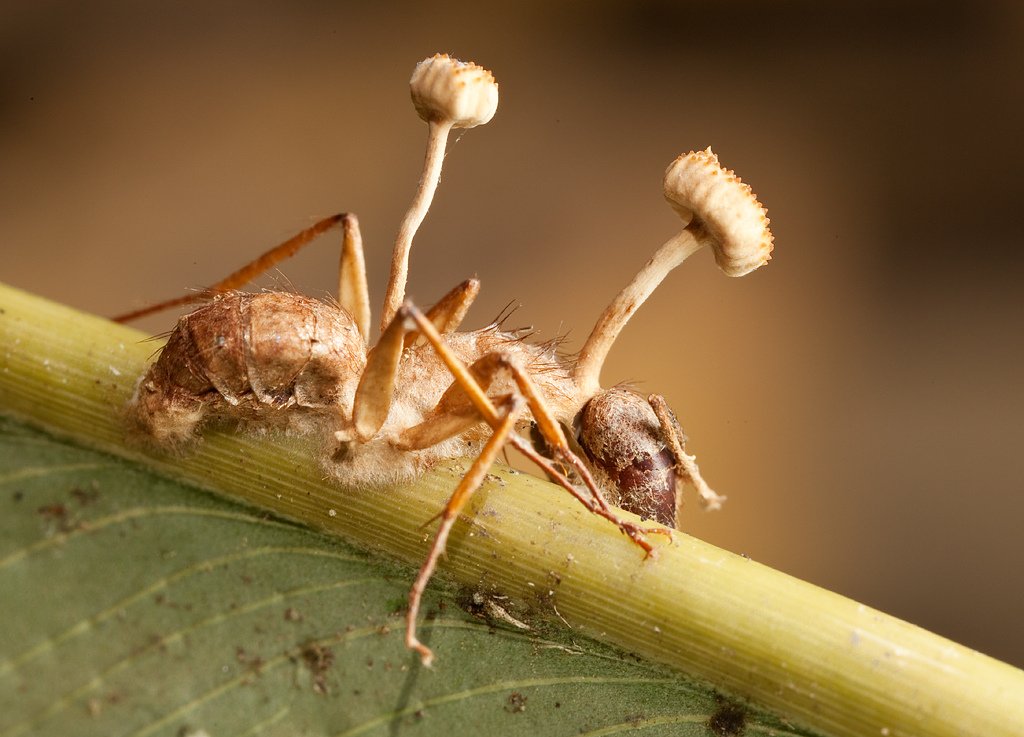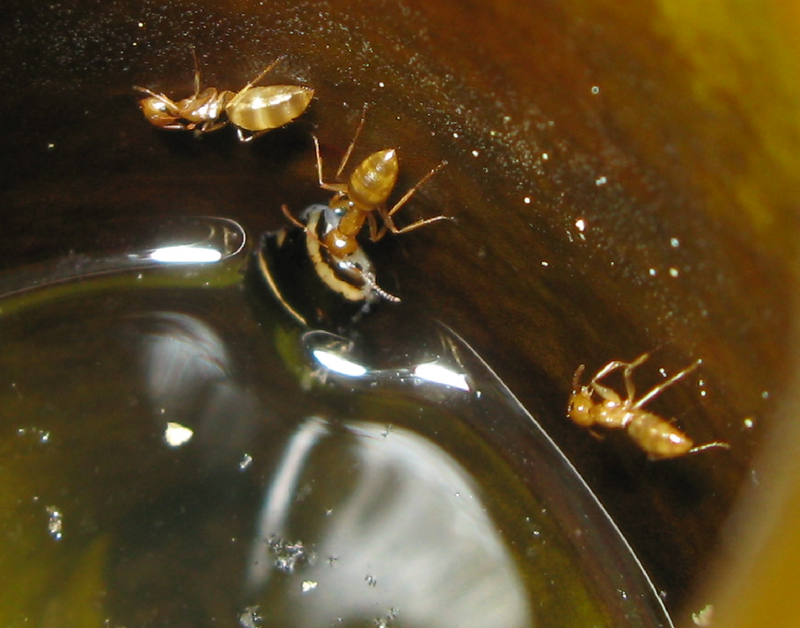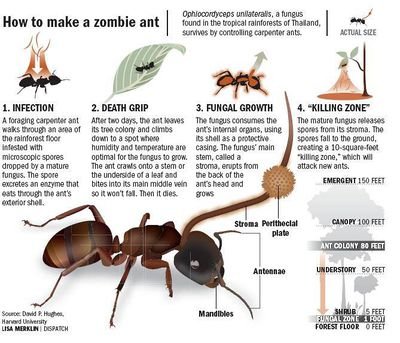This is the third and last part of my "World's Strangest Ants" mini-series. Click here for part 1 and here for part 2 in case you missed them!
9# The Zombie Ant
 (credit: Linden Gledhill )
(credit: Linden Gledhill )
First on today's part are the ants infected by the fungi "Ophiocordyceps unilateralis", commonly known as the zombie fungus. This fungi was recently reclassified so you may also encounter it in the literature as Cordyceps unilateralis.
O. unilateralis is a entomopathogen fungus, endemic to the rain-forests of Brazil and in the tropical forest regions of Thailand. It's called the zombie fungu because it modifies the behavior of its' host, mainly ants of the Camponotus leonardi species, essentially turning them into zombies...or slaves..or whatever you prefer to call them.
Once infected, the ants lose their free will, leave their nests, climb a tall plant, use their mandibles to affix themselves on the underside of a leaf and remain there until they eventually die. Soon after, the fruiting bodies of the fungus sprout out of their heads, releasing and starting a new cycle.
Here's a video narrated by Sir David Frederick Attenborough showing the process from start to finish:
And here's cool info-graph summarizing the life-cycle of O. unilateralis:
(credit)
Here's also a link to an old post of mine, dedicated to the fungus if you want to learn more it!
In case you wonder, no, O. unilateralis can't infect humans, just Camponotus ants, so a fungi-zombie-apocalypse isn't happening anytime soon!
10# The Ant With No Worker Caste
 Solenopsis daguerrei male (credit)
Solenopsis daguerrei male (credit)
I am sure you know how each ant colony is typically comprised of one (sometimes a few) queen, a bunch of males and thousands of sterile female workers. These workers do essentially alh the work, from bringing food to making tunnels to taking care of the queen and the young to whatever.
But what if I told you that there is actually an ant species that actually has no workers at all? How does it manage to pull it of? Who is doing all the hard work? Let me introduce you to Solenopsis daguerrei, a parasitic ant native to Argentina and Uruguay. This species is consisted only of queens and males and has no workers, soldiers or other castes.
So here's how it goes. After mating, the female queens fly off to invade nests of other closely related ants, like the red imported fire ant (Solenopsis invicta). Their pheromones are very similar to the host and they manage to move undetected.
Eventually, the S. daguerrei queen locates the host's queen, latches on her body and feeds on the the food the workers bring for her! Over the course of time, the real queen dies slowly from starvation! The host's workers even take care of the eggs laid by the parasitic queen, often preferentially to their own!
11# The Diving Ant
 Camponotus schmitzi taking a dive in Nepenthes bicalcarata pitcher plant (credit)
Camponotus schmitzi taking a dive in Nepenthes bicalcarata pitcher plant (credit)
If you are an insect and happen to fall into a Pitcher plant your fate is sealed. You are going to have a slow and painful death as the digestive fluids of the plant slowly dissolve your body. That is unless you are a Camponotus schmitzi ant!
Camponotus schmitzi is a species of carpenter ant from Borneo that is commonly known as the diving ant. Some other common names it comes by are swimming ant or pitcher-plant ant and as you have probably guessed it's named this way because it likes to dive in the digestive fluids of pitcher plants, specifically those of the Nepenthes bicalcarata species.
These ants build their nests in the hollow tendrils of the plant and depend entirely on the insects that get trapped by the plant! Interestingly, the ants seem to have a preference for only large prey and ignore the smaller insects, which seems to be beneficial for the plant:
In this way the contents of N. bicalcarata pitchers is controlled such that organic matter does not accumulate to the point of putrefaction, which can lead to the demise of pitcher infauna (which also appear to benefit the plant) and sometimes the pitcher itself. (source)
The End (For Now)
So this brings us to the end of this mini series of weird ants. I really hope you enjoyed reading about them as much as I enjoyed writing this post! Don't forget to leave a comment if you know of any other weird ones, who knows, maybe I will write a bonus 4 in the future!
 More Strange Animals
More Strange Animals
If you enjoyed reading this post I am sure you will love some of my previous work:
- Meet The World's Strangest Ants (Part 1/3)
- The Squid With The Human-Like Teeth! (Promachoteuthis sulcus!)
- 4 Very Strange Animals I First Heard Of This Week
- Halloween Special: A Real-Life Monster Compilation
- Alien-Like Moth With Tentacles Terrifies The Internet - But Is This Creature Real?
- This Hummingbird Is Just So Weird! Can You Guess Why?
- This Deep Sea Creature Looks Like An Alien Spaceship
- World's Largest Millipede VS Smallest Millipede
- 7 Horrifying Micro-Monsters That Will Haunt Your Dreams




